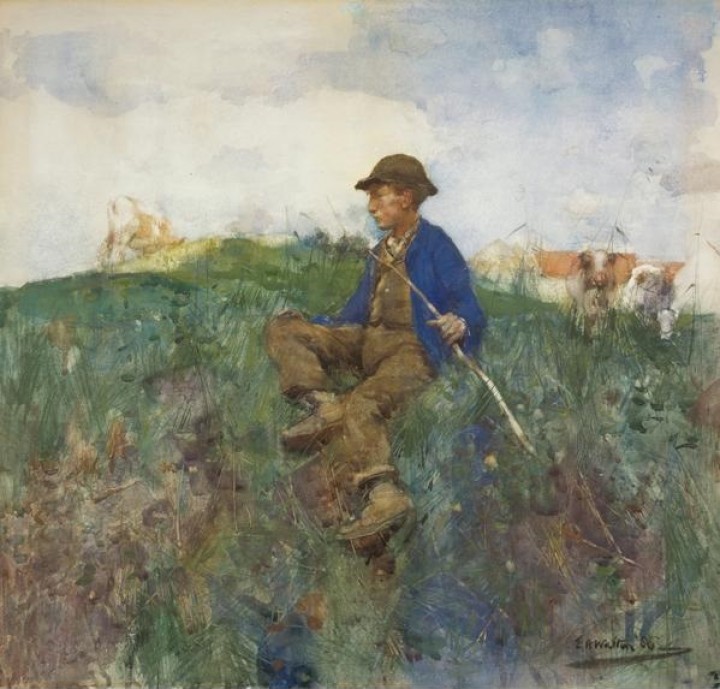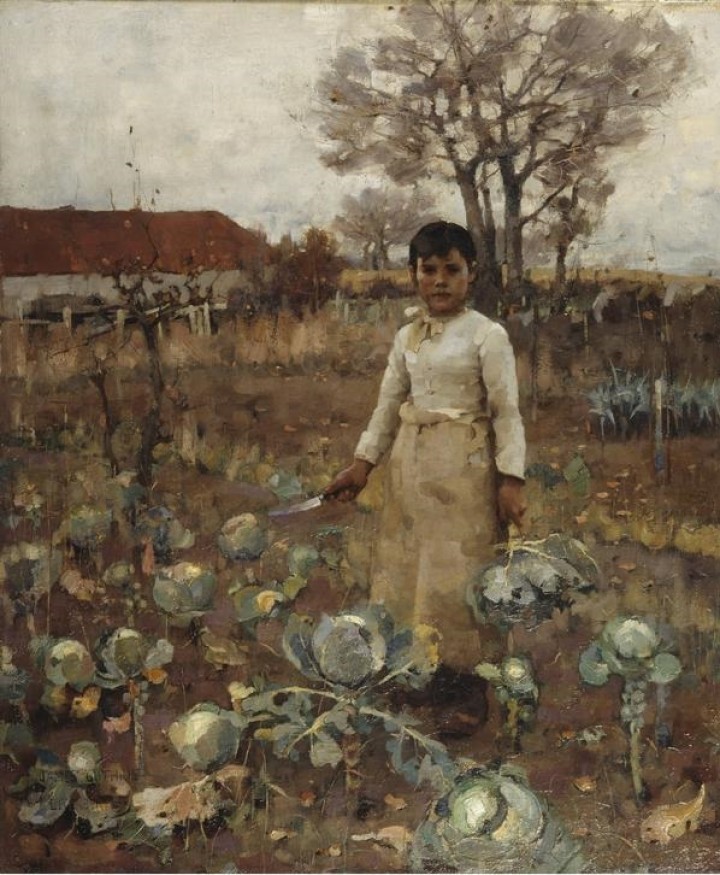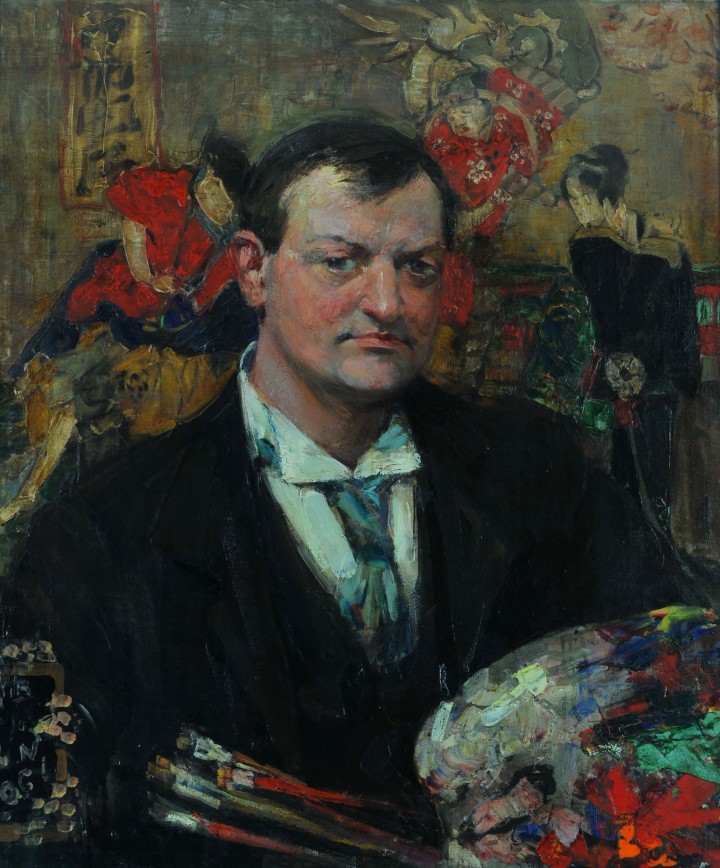Scottish Art News
Latest news
Magazine
News & Press
Publications
The Glasgow Boys and Girls
By Lachlan Goudie, 05.09.2020

I am a Glasgow boy. I was born in that city and my father, the artist Alexander Goudie, studied and taught at the Glasgow School of Art.
The legacy of those late 19th-century artists who came to be known as the ‘Boys’, made a deep impression on my dad. When I was a young apprentice painter, he taught me their techniques and alerted me to the qualities which distinguished their work; assiduous control of tone, the use of square-edged brushes, an affinity with those French painters whose approach combined realism and naturalism.
Growing up in the West of Scotland, however, it always perplexed me that the Boys largely chose to ignore the dramatic landscape of the Highlands and Hebridean islands that lie on the city’s doorstep. Instead they migrated towards the quieter geography of Southern Scotland – Kirkcudbright, Moniaive and in particular the area around Cockburnspath in the Borders. It was here that the Glasgow Boys created some of their most celebrated paintings.
I recently spent ten wintry days near Cockburnspath in the small village of Abbey St Bathans, nestled amidst the ancient forests of Berwickshire. It was the first time I had ever painted in the region and the experience gave me an insight into the kinds of subjects that had so fascinated the Boys and how the landscape influenced their approach to the canvas.
Whatever the season, painting outdoors in Scotland is challenging – the weather conditions and the appearance of the landscape can change from minute to minute. In winter however, the biggest problem (even more than the snowsqualls I experienced) is that constant cloud cover and a lack of strong sunlight can make the landscape appear very flat. A subject without pronounced shadows and defined by an almost monochromatic range of colours, risks producing a mighty dull painting. The Glasgow Boys, however, were ‘tonal’ painters. They were fascinated by the subtle transitions between light and shade produced by natural lighting conditions.
During my week in the Borders, I found the combination of soft light and the gentle contours of the geography a tough problem to resolve. I learned that to convey tone successfully you have to scrutinise the smallest variations in colour and form that define your subject. What’s more, without pronounced colour contrasts to provide a sense of depth, you have to structure your compositions clearly in order to give each image coherency and graphic impact. Working in the same open air studio as my predecessors, I undoubtedly left Abbey St Bathans with a renewed admiration for the controlled precision of the work of those Glasgow Boys.
EA Walton, The Herd Boy, 1886
It was Edward Arthur Walton and his great friend James Guthrie who first ‘discovered’ Cockburnspath in 1883. For these artists, the farming community and surrounding landscape provided a subject in which they could immerse themselves.
Walton and his colleagues revered the work of the self-professed ‘peasant painter’, Jules Bastien-Lepage. His hyper-realistic images depicted French fieldworkers, observed in a rural setting and under cool lighting conditions. These paintings monumentalised their subjects. In this large watercolour, Walton is clearly emulating his artistic hero.
The use of a square format, the high horizon and central positioning of the herd boy creates a composition with graphic punch. And although the sun has broken out from behind the Berwickshire clouds, the boy remains in shadow. This allows Walton to describe the figure in muted, earthy tones – a perfect counterpoint to his striking ultramarine jacket – and to frame him powerfully against the sun-filled sky.
James Guthrie, A Hind’s Daughter, 1883
 James Guthrie, A Hind's Daughter, 1883. Courtesy National Galleries Scotland. Photography by Antonia Reeve.
James Guthrie, A Hind's Daughter, 1883. Courtesy National Galleries Scotland. Photography by Antonia Reeve.
Throughout the mid-19th century, painters like Horatio McCulloch had regularly celebrated the awesome scale of Scotland’s Highlands. The Boys reacted against this bombastic style and the treacly palette of colours employed by artists whom they labelled as ‘Glue-pots’.
In this canvas, Guthrie substitutes vast panoramas for the close up of a young girl collecting kail, or cabbage, from a muddy Berwickshire field. In place of visual drama, he uses a palette of colours that is calibrated to reproduce the effect of natural light. And although the composition appears incidental, it is in fact carefully structured to confer a sense of natural authority on its subject.
Whilst most of his colleagues only visited Cockburnspath during the summer months, Guthrie embedded himself there in the winter too – like his hero Bastien-Lepage, who retreated from Paris to live and paint all year in the provincial village of Damvillers.
From November to February, as the cabbages were harvested, Guthrie was there to observe and document the life of the community around him. These experiences inspired ‘A Hind’s Daughter’, an extraordinary distillation of all the principles which underpinned the work of the Glasgow Boys.
Arthur Melville, The Highland Glen, c. 1893
 Arthur Melville, The Highland Glen, c. 1893. The Fleming Collection.
Arthur Melville, The Highland Glen, c. 1893. The Fleming Collection.
Arthur Melville was never a fully paid-up member of the Glasgow group. However his work was revered by many of the ‘Boys’.
In the winter of 1882, Melville joined James Guthrie in Cockburnspath, having only recently returned from a two-year journey across Egypt and the Middle East. Whilst Melville, like Guthrie, was concerned with observing subtle variations in tonal values, his travels had also opened his eyes to the chromatic power of sunlight and colour. Melville documented his journey in a series of vibrant watercolours and when he returned to Scotland, he continued using this medium and the experimental style he had developed abroad to interpret the landscape of his homeland.
This watercolour was painted in 1893 and showcases many of the bold and semi-abstract effects that earned his watercolour technique the label ‘blottesque’. Watercolour is a medium that allows you to flood the page with pigment and lends itself to abstraction. Melville imposes just enough definition and colour on this image to evoke the fleeting sunlight and humid atmosphere of a sodden, autumnal glen.
James Paterson, Winter Sunshine, Moniaive, 1889
 James Paterson, Winter Sunshine, Moniaive, 1889. The Fleming Collection.
James Paterson, Winter Sunshine, Moniaive, 1889. The Fleming Collection.
James Paterson was deeply invested in the landscape around the Dumfriesshire village of Moniaive. Like his colleagues in Cockburnspath, he avoided scenery that was conventionally picturesque or overly dramatic. Instead he chose low-key, almost incidental subjects. This allowed him to concentrate on conveying textures and a quality of light that feel particular to Scotland.
Autumn and winter were the seasons he described on canvas most evocatively. When painting outside in February, however, the finger-numbing and shiver-inducing cold is a challenge which conspires to dull your concentration and drain your painting stamina. As artists like Guthrie and Paterson experienced (and as I did recently in Abbey St Bathans), inclement conditions often force you to summarise what you can see, pushing you to communicate the atmosphere and appearance of your environment by the most economical means. This painting uses a disarmingly simple composition and the blocking out of areas of colour to produce a talismanic evocation of Scotland in winter.
John Lavery, The Bridge at Hesterworth, 1884
 John Lavery, The Bridge at Hesterworth, 1884. The Fleming Collection.
John Lavery, The Bridge at Hesterworth, 1884. The Fleming Collection.
The Glasgow Boys admired the group of French painters, including Jean-François Millet and Charles Daubigny, who had gathered in the French village of Barbizon and painted the landscape in a realist manner. When John Lavery went to Grez-sur-Loing in 1883, he joined a group of artists who were self-consciously emulating the painting colony established at Barbizon in the 1830’s. Lavery, however, brought a contemporary eye to the challenges of painting images directly from nature and emulating the qualities of outdoor light – issues which preoccupied both the Barbizon artists and the Glasgow Boys.
As a young man, Lavery was apprenticed to a photographer in Glasgow. In ‘The Bridge at Hesterworth’, Lavery’s unusual letter-box format (one which he used repeatedly throughout his career) allows the eye to pan across the landscape and has the effect of cropping the subject in a manner which was perhaps indebted to photographic techniques.
Similarly, like a photographer choosing to underexpose an image in order to create a particular atmosphere, Lavery keys down all the colours in this image. He blends tonal values together and paints the areas under the bridge and along the riverbank with an impenetrable, inky-darkness.
Bessie MacNicol, Portrait of EA Hornel
 Bessie MacNicol, Portrait of EA Hornel. National Trust for Scotland, Broughton House & Garden.
Bessie MacNicol, Portrait of EA Hornel. National Trust for Scotland, Broughton House & Garden.
It was only in the latter half of the 19th century that female artists started enjoying the freedom to study and work on a par with their male counterparts. To some extent, the term ‘Glasgow Boys’ has overshadowed the talent of women artists at the time who associated with the group. First among them, in my opinion, was Bessie MacNicol.
Bessie was a force of nature in her personality and her prodigious painting ability. She studied at the Glasgow School of art and was one of the first female artists in Scotland to attend classes at the Academie Colarossi in Paris, frequented by so many of her male contemporaries.
MacNicol painted sensuous portraits that were full of light and life and she handled paint with bravura fluidity. This image of her great friend EA Hornel was completed in his studio in the Galloway town of Kirkcudbright where he lived and worked. It demonstrates the combination of tenderness, empathy and colourful vigour that were typical of her work.
Lachlan Goudie is an artist. He grew up in Glasgow and is the son of the Scottish painter, Alexander Goudie. His paintings have won numerous awards and he is an elected member of the Royal Institute of Oil Painters. Lachlan wrote and presented the landmark BBC television series The Story of Scottish Art and has presented numerous other documentaries for the BBC including Painting the Holy Land and Mackintosh: Glasgow’s Neglected Genius. The Story of Scottish Art, by Lachlan Goudie, has been published by Thames & Hudson, priced £29.95.
'The Glasgow Boys & Girls' is on show at The Granary Gallery, Berwick-upon-Tweed, from 5th September to 15th November. Not all images shown here are on display.




